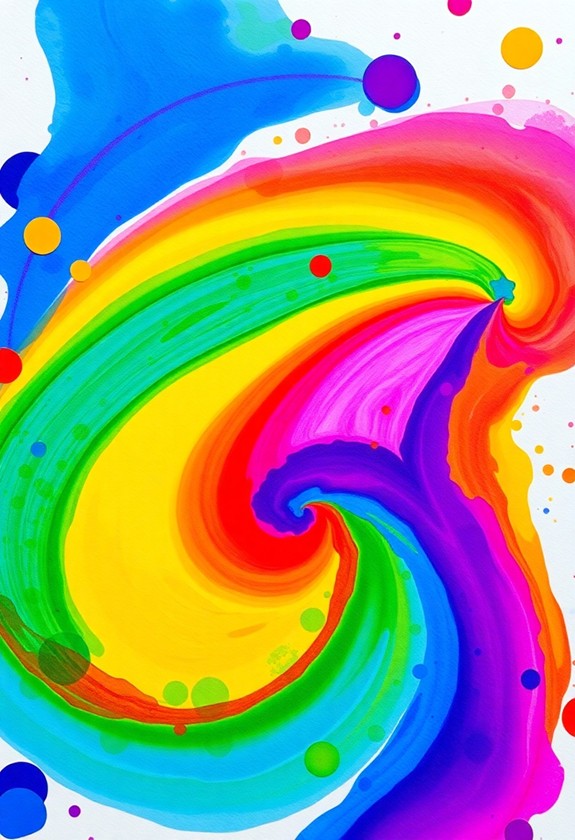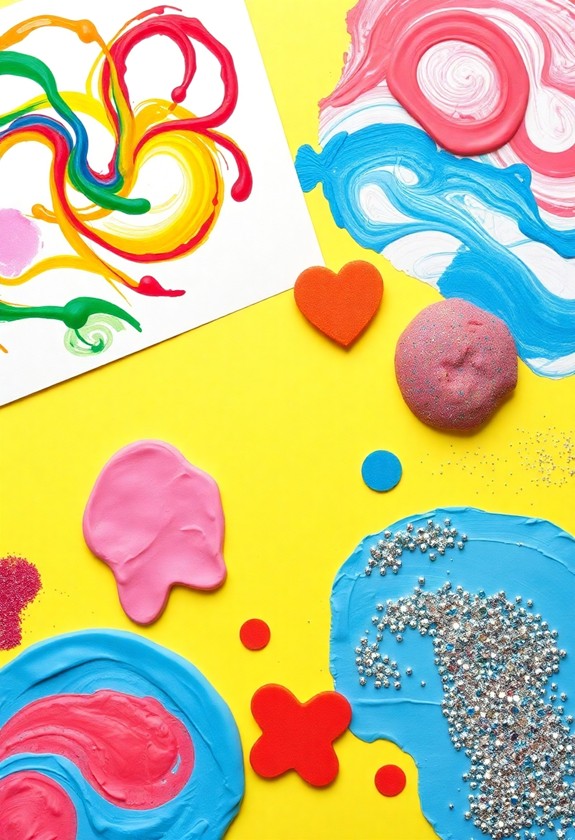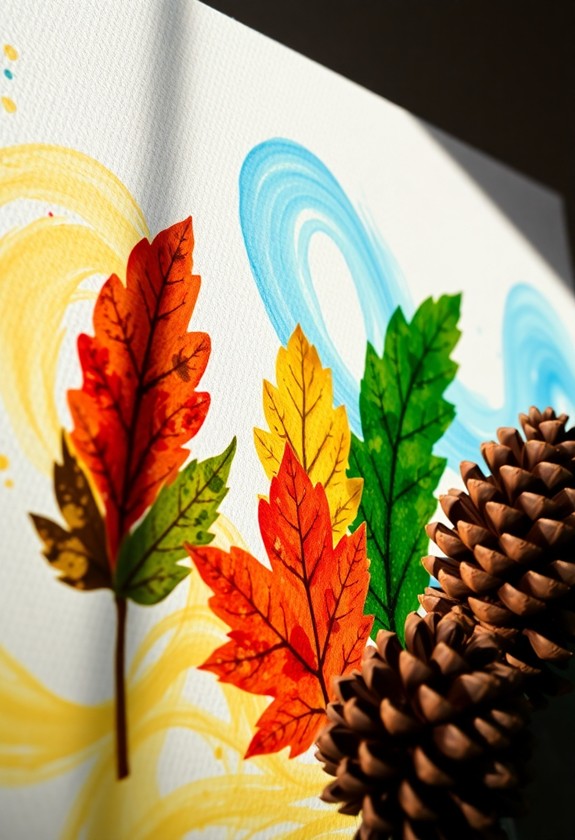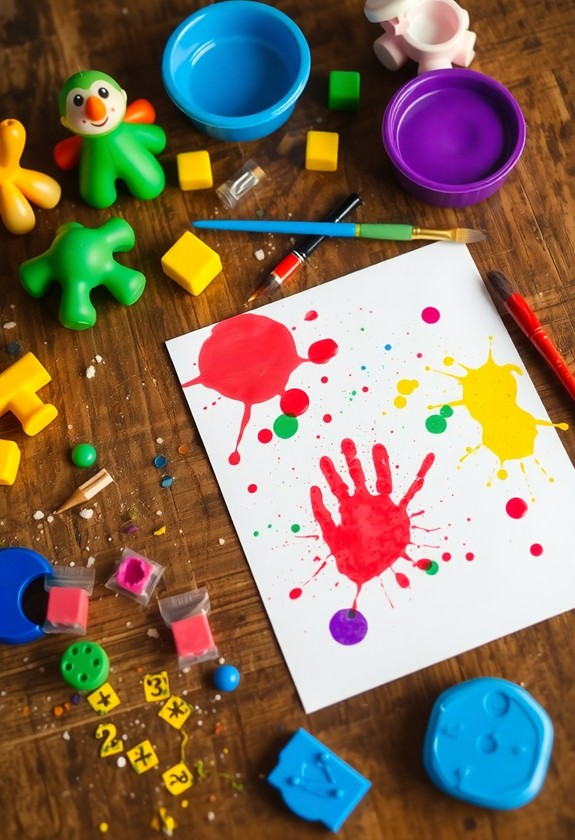Get ready for some colorful fun! These 5 exciting activities will have your preschoolers mixing and investigating in no time. Try Rainbow Ice Cube Painting for a cool, melty masterpiece. Squish and squeeze with Color Mixing Sensory Bags – mess-free and magical! Create a liquid rainbow with the Layered Color Bottle Experiment. Swirl up some foamy fun with Shaving Cream Color Swirls. And watch colors walk with the Colorful Walking Water Science project. Each activity is packed with hands-on learning and artistic revelation. But wait, there's more to unravel about these lively adventures!
Creative Highlights
- Rainbow Ice Cube Painting combines color theory with sensory play as children create art using melting colored ice cubes.
- Color Mixing Sensory Bags offer a mess-free way for preschoolers to explore color mixing through tactile manipulation.
- Layered Color Bottle Experiment introduces basic science concepts while creating a visually striking liquid rainbow.
- Shaving Cream Color Swirls allow children to mix colors and create patterns in a fun, textured medium.
- Colorful Walking Water Science demonstrates capillary action and color mixing through an engaging, easy-to-set-up experiment.
Rainbow Ice Cube Painting
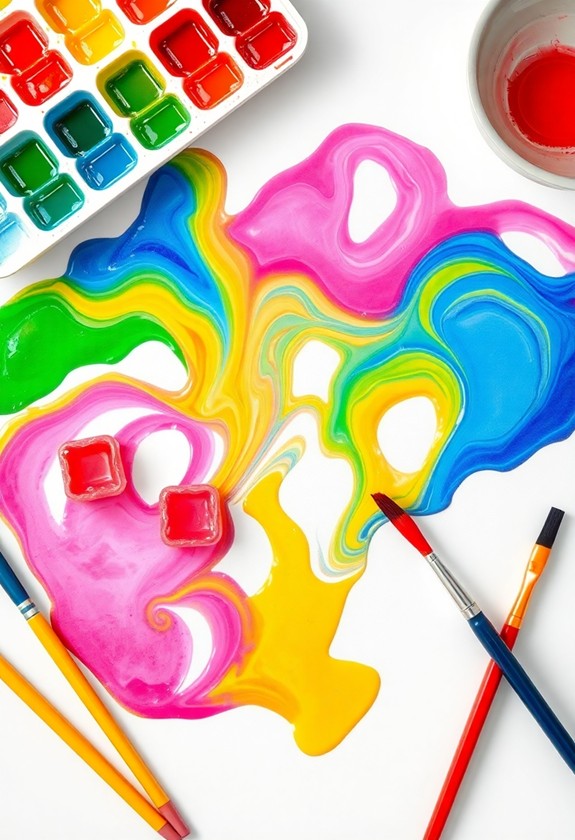
Rainbow Ice Cube Painting offers a rejuvenating twist on color mixing for preschoolers. It's a cool way to investigate colors and create lively art! Here's how to get started:
- Freeze colored water in ice cube trays
- Set up paper on a tray or table
- Let kids paint with the melting cubes!
As the ice melts, it'll leave colorful trails behind. Watch in awe as the hues blend and swirl! This frosty activity isn't just fun – it's a great lesson in color theory too. Kids will learn how primary colors mix to form secondary ones. Plus, they'll develop fine motor skills as they manipulate the slippery cubes. For an added educational element, consider incorporating educational posters that showcase color wheels and basic art concepts to improve the learning experience.
But wait, there's more! Try adding salt to the ice for extra texture, or use different-shaped molds for unique effects. Get ready for a flurry of creativity!
Color Mixing Sensory Bags
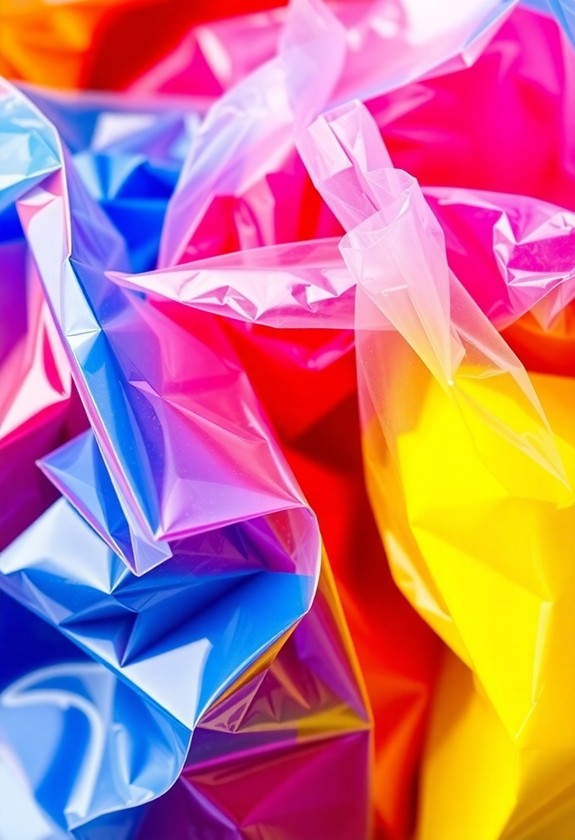
After investigating icy color mixing, let's warm things up with Color Mixing Sensory Bags. These squishy, colorful pouches are a tactile delight that'll have your preschoolers squealing with joy! Non-toxic, washable materials guarantee a safe and mess-free experience for your little artists.
Here's what you'll need:
- Ziplock bags
- Hair gel
- Food coloring
- Duct tape
Fill each bag with hair gel and add different primary colors. Seal them tight and reinforce with duct tape. Now, it's time to play! Let your little artists squish, squeeze, and smoosh the bags to mix colors. Watch their eyes light up as red and yellow blend into orange, or blue and yellow create green!
But wait, there's more! Challenge your kiddos to:
- Make specific colors
- Create color gradients
- Write letters in the gel
Get ready for a bag full of laughs and learning!
Layered Color Bottle Experiment
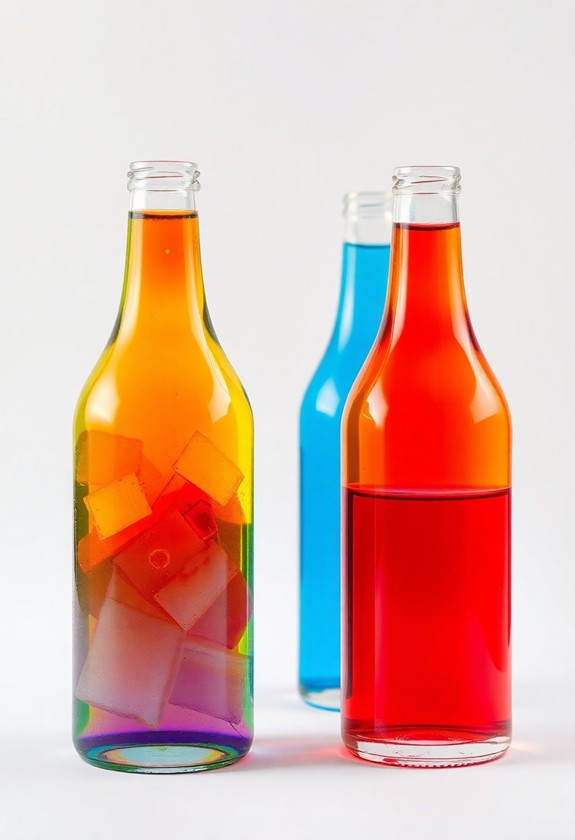
This enchanting experiment brings the magic of a liquid rainbow to life in a bottle. You'll be amazed as different colored liquids stack on top of one another, creating a stunning visual effect! Non-toxic materials guarantee safety for young children during investigating creativity, making this activity perfect for preschoolers. The washable nature of these supplies likewise means easy cleanup after the fun.
Here's what you'll need:
- A clear bottle
- Water
- Food coloring
- Honey
- Dish soap
- Vegetable oil
Let's get mixing:
- Pour honey into the bottle
- Add dish soap (carefully!)
- Mix water with food coloring
- Slowly pour colored water in
- Top it off with vegetable oil
Watch in wonder as the liquids settle into distinct layers. The science behind it? Density! Each liquid has a different weight, causing them to separate. It's like a colorful tower of fun! This bottle of rainbow goodness isn't just pretty – it's a perfect opportunity to discuss scientific concepts with your little ones.
Shaving Cream Color Swirls
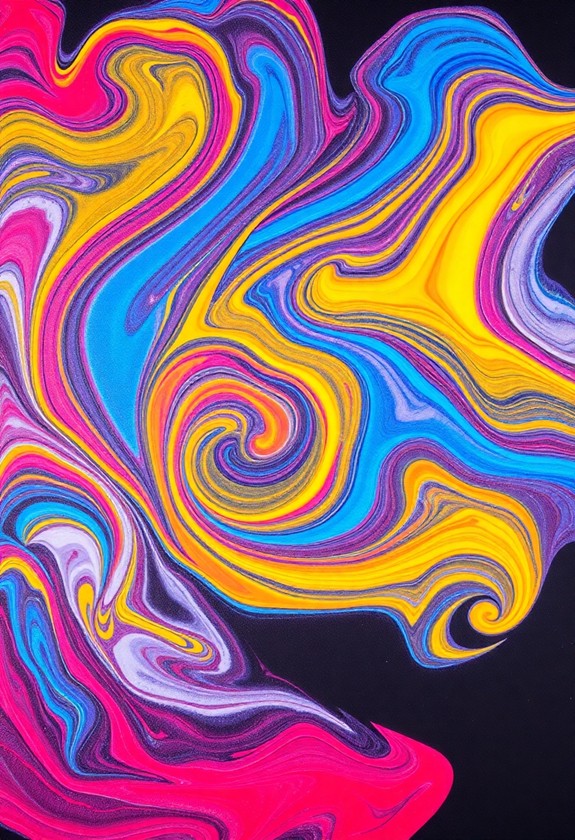
Shaving cream swirls offer a mesmerizing color-mixing experience for preschoolers. Get ready for a swirl-wind adventure! Here's what you'll need:
- Shaving cream
- Food coloring
- Shallow tray
- Popsicle sticks
Start by squirting shaving cream onto the tray. Smooth it out, creating a blank canvas. Now, add drops of different food colors across the surface. It's time to make some colorful magic! Let your little artists use popsicle sticks to swirl the colors together. Watch as they create stunning patterns and uncover new hues!
But wait, there's more! Try these fun variations:
- Rainbow swirls: Use all the colors of the rainbow
- Seasonal themes: Pick colors that match holidays or seasons
- Name art: Swirl colors to spell out names
This activity is foam-tastic and certain to bring smiles!
Colorful Walking Water Science
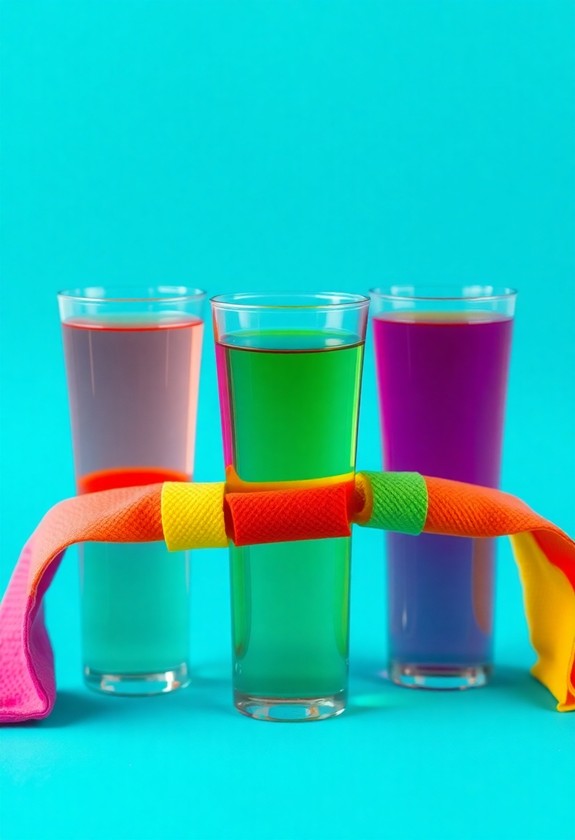
Walking water science offers a magical color-mixing experiment that'll enchant preschoolers. It's like a rainbow bridge between glasses! Here's how to do it:
- Gather 6 clear glasses, food coloring, and paper towels.
- Fill every other glass with water.
- Add red, yellow, and blue food coloring to the water-filled glasses.
- Fold paper towels into strips.
- Connect the glasses with paper towel bridges.
Watch in awe as the colors climb up the paper towels and mix in the empty glasses! It's like they're playing color tag! The water defies gravity and "walks" along the paper towels, creating new hues. This colorful experiment teaches preschoolers about capillary action and color mixing. Plus, it's a great way to introduce scientific observation. Get ready for excited squeals and wide-eyed wonder!
Curious Little Questions
Are These Activities Suitable for Children With Color Blindness?
Although color blindness can present challenges, you can still make art activities fun and inclusive for all kids. Try these tips:
- Use textures and patterns instead of colors
- Label materials with names or symbols
- Focus on shapes and designs
- Encourage sensory exploration
- Use high-contrast colors
How Can I Modify These Activities for a Large Classroom Setting?
Like a rainbow bursting onto a giant canvas, you can adapt color mixing activities for a large classroom! Here's how:
- Set up color stations around the room
- Divide kids into small groups
- Rotate groups through stations
- Use washable, easy-to-clean materials
- Try whole-class demos on a projector
- Create a "color mixing zone" for exploration
Get creative! With these tweaks, your classroom will be a kaleidoscope of fun and learning. Remember, the bigger the group, the more colorful the chaos – but that's half the excitement!
What Precautions Should Be Taken to Protect Clothing During These Activities?
You'll want to protect those precious clothes during your colorful adventure! Here's how:
- Grab some smocks or old t-shirts – they're your paint-fighting armor!
- Roll up those sleeves, it's time to get messy!
- Lay down newspaper or plastic sheets – your floor will thank you!
- Use washable paints – they're your secret weapon against stubborn stains!
- Keep wet wipes handy for quick clean-ups!
Can These Color Mixing Activities Be Adapted for Older Children?
You can totally level up these activities for older kids. Imagine a 12-year-old creating a masterpiece with advanced color theory! Here's how:
- Use scientific concepts like pH indicators
- Investigate optical illusions with color
- Introduce digital color mixing on tablets
- Try natural dyes from plants and foods
These adaptations aren't just fun, they're educational too! Older children will love the challenge and complexity. Plus, they'll gain a deeper understanding of color relationships. It's a win-win for creativity and learning!
Are There Any Eco-Friendly Alternatives for the Materials Used in These Experiments?
You've got plenty of eco-friendly options for your color mixing experiments. Try these earth-loving alternatives:
- Use natural pigments from fruits, veggies, and spices
- Mix up homemade paints with flour, salt, and water
- Experiment with plant-based food coloring
- Create recycled paper for your art projects
- Opt for biodegradable glitter made from plants
You'll be a green art machine in no time! These swaps aren't just good for the planet – they're fun and exciting too. Get ready to mix, match, and create!

